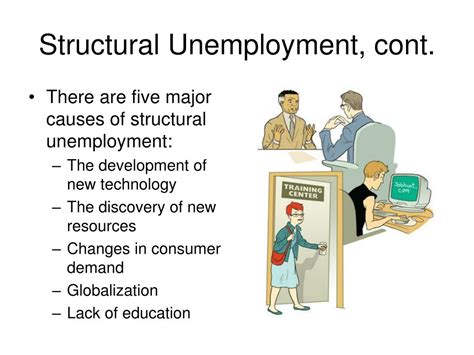Structural Unemployment: Definition And Examples

Unemployment is a significant issue that affects individuals, families, and economies around the world. While there are various types of unemployment, one particular type that poses unique challenges is structural unemployment. In this article, we will explore the definition of structural unemployment, its causes, and provide examples to help illustrate its impact.
What is Structural Unemployment?
Structural unemployment refers to a long-term and persistent unemployment that arises due to a mismatch between the skills and qualifications of job seekers and the available job opportunities in the market. Unlike other types of unemployment, such as cyclical or frictional unemployment, structural unemployment is not directly influenced by economic fluctuations or temporary factors.
Causes of Structural Unemployment
There are several factors that contribute to the emergence of structural unemployment:
- Technological Changes: Advances in technology and automation can lead to the obsolescence of certain job roles, making it difficult for individuals with outdated skills to find suitable employment.
- Globalization: Increased international trade and outsourcing can result in the relocation of industries, causing job losses in certain sectors and creating a mismatch between the skills demanded by employers and those possessed by workers.
- Demographic Changes: Shifting demographics, such as an aging population or changes in birth rates, can affect the demand for certain types of jobs and result in structural unemployment.
- Education and Training: Inadequate education and training systems may fail to equip individuals with the necessary skills and qualifications required for available job opportunities.
- Geographical Factors: Disparities in job opportunities between different regions or lack of mobility can contribute to structural unemployment, particularly in areas with declining industries.
Examples of Structural Unemployment
To better understand structural unemployment, let’s explore a few examples:
Example 1: Technological Advancements
In recent years, the rise of e-commerce has significantly impacted traditional brick-and-mortar retail stores. As consumers increasingly turn to online shopping, many retail workers have found themselves without employment opportunities. These workers may lack the digital skills necessary to transition into e-commerce roles, leading to structural unemployment.
Example 2: Globalization and Outsourcing
When manufacturing industries move their production facilities to countries with lower labor costs, workers in the home country may face job losses. This disruption can result in a structural unemployment situation where the affected workers struggle to find alternative employment due to a lack of transferable skills or limited job opportunities in their local area.
Example 3: Changes in Industry Demand
As renewable energy sources gain prominence and the demand for fossil fuels decreases, workers in the coal mining industry may experience structural unemployment. The skills required for mining jobs may not align with the skills needed in the renewable energy sector, leaving many coal miners unemployed and in need of retraining or relocation.
Conclusion
Structural unemployment is a complex issue that arises due to a mismatch between job seekers’ skills and available job opportunities. Technological advancements, globalization, demographic changes, education and training systems, and geographical factors all contribute to this type of unemployment. By understanding the causes and examples of structural unemployment, policymakers and individuals can work towards implementing strategies to address this issue and provide support to those affected.
Frequently Asked Questions
Q: How is structural unemployment different from other types of unemployment?
A: Structural unemployment is different from other types of unemployment, such as cyclical or frictional unemployment, because it is not directly influenced by economic fluctuations or temporary factors. It arises due to a mismatch between skills and available job opportunities.
Q: How can individuals affected by structural unemployment find new job opportunities?
A: Individuals affected by structural unemployment can explore opportunities for retraining or acquiring new skills that are in demand in the current job market. They can also consider relocating to areas with more job prospects or seek assistance from job placement agencies and career counseling services.
Q: What role can governments play in addressing structural unemployment?
A: Governments can play a crucial role in addressing structural unemployment by investing in education and training programs that equip individuals with the skills needed for available job opportunities. They can also implement policies that promote economic diversification, support industries undergoing structural changes, and provide financial assistance to those affected by unemployment.
Q: Can structural unemployment be completely eliminated?
A: While it may be challenging to completely eliminate structural unemployment, proactive measures can be taken to minimize its impact. This includes fostering a flexible and adaptable education system, promoting continuous learning and upskilling, and creating an environment that encourages entrepreneurship and innovation.

